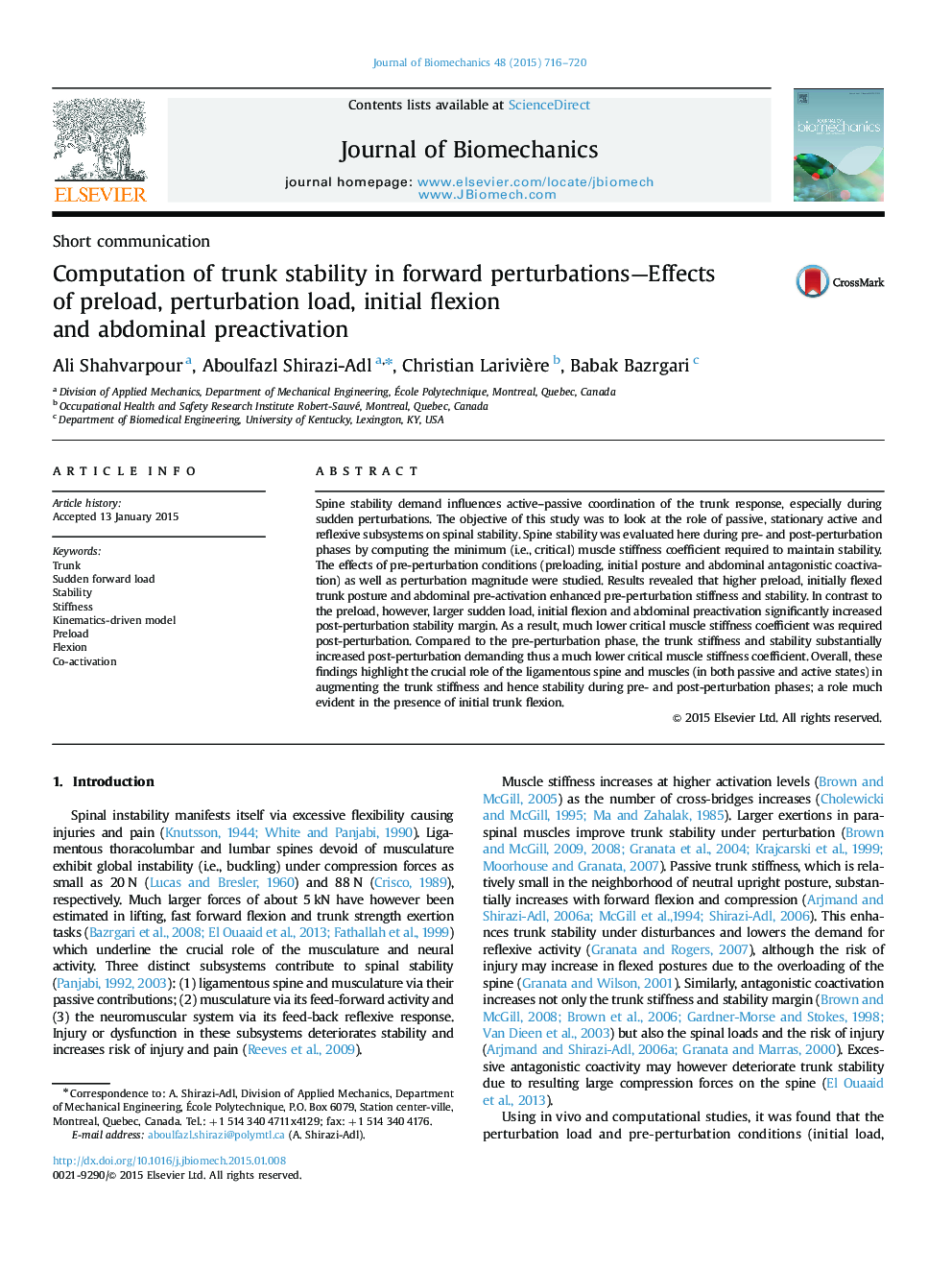| کد مقاله | کد نشریه | سال انتشار | مقاله انگلیسی | نسخه تمام متن |
|---|---|---|---|---|
| 10431743 | 910223 | 2015 | 5 صفحه PDF | دانلود رایگان |
عنوان انگلیسی مقاله ISI
Computation of trunk stability in forward perturbations-Effects of preload, perturbation load, initial flexion and abdominal preactivation
ترجمه فارسی عنوان
محاسبه ثبات تنه در اختلالات رو به جلو-تأثیر پیش بار، بار تخلخل، فلج شدن اولیه و پیش آگاهی شکم
دانلود مقاله + سفارش ترجمه
دانلود مقاله ISI انگلیسی
رایگان برای ایرانیان
کلمات کلیدی
ترجمه چکیده
تقاضای پایداری ستون فقرات بر هماهنگی فعال غیرفعال از پاسخ تنه تأثیر می گذارد، به ویژه در هنگام اختلالات ناگهانی. هدف از این مطالعه، بررسی نقش سیستم های غیر فعال، ثابت و بازتابی بر پایایی ستون فقرات است. پایداری ستون فقرات در مرحله قبل و پس از تحریک با استفاده از محاسبه ضریب سختی عضله حداقل (یعنی بحرانی) مورد نیاز برای حفظ ثبات در اینجا مورد ارزیابی قرار گرفت. تاثیر شرایط قبل از تحریک (پیش بارگذاری، وضعیت اولیه و فعالیت آنتاگونیست شکمی) و همچنین میزان تحریکات مورد بررسی قرار گرفت. نتایج نشان داد که پیش بارگذاری بالاتر، ابتدا انعطاف پذیری تنه تنه و پیش فعال سازی شکمی افزایش سفتی و پایداری قبل از تحریک را افزایش داد. با این حال، در مقایسه با پیش بارگیری، بار ناگهانی بزرگتر، ابتدای فلج شدن و پیش زدن شکم به طور قابل توجهی مانع از مانع ثبات پس از اختلال شد. در نتیجه، ضریب سختی عضله بسیار پایین تر مورد نیاز پس از اختلال بود. در مقایسه با مرحله قبل از تحرک، سختی و استحکام تنه به طور قابل ملاحظه ای پس از اختلال افزایش می یابد و در نتیجه ضریب سختی عضلانی بسیار پایین تر را افزایش می دهد. به طور کلی، این یافته ها نقش حیاتی ستون فقرات و عضلات لگنژاد (در حالت های غیر فعال و فعال) را در تقویت سختی تنه و به تبع آن پایداری در مراحل قبل و بعد اختلال برجسته می کند. نقش بسیار برجسته ای در حضور لگن اولیه شکم وجود دارد.
موضوعات مرتبط
مهندسی و علوم پایه
سایر رشته های مهندسی
مهندسی پزشکی
چکیده انگلیسی
Spine stability demand influences active-passive coordination of the trunk response, especially during sudden perturbations. The objective of this study was to look at the role of passive, stationary active and reflexive subsystems on spinal stability. Spine stability was evaluated here during pre- and post-perturbation phases by computing the minimum (i.e., critical) muscle stiffness coefficient required to maintain stability. The effects of pre-perturbation conditions (preloading, initial posture and abdominal antagonistic coactivation) as well as perturbation magnitude were studied. Results revealed that higher preload, initially flexed trunk posture and abdominal pre-activation enhanced pre-perturbation stiffness and stability. In contrast to the preload, however, larger sudden load, initial flexion and abdominal preactivation significantly increased post-perturbation stability margin. As a result, much lower critical muscle stiffness coefficient was required post-perturbation. Compared to the pre-perturbation phase, the trunk stiffness and stability substantially increased post-perturbation demanding thus a much lower critical muscle stiffness coefficient. Overall, these findings highlight the crucial role of the ligamentous spine and muscles (in both passive and active states) in augmenting the trunk stiffness and hence stability during pre- and post-perturbation phases; a role much evident in the presence of initial trunk flexion.
ناشر
Database: Elsevier - ScienceDirect (ساینس دایرکت)
Journal: Journal of Biomechanics - Volume 48, Issue 4, 26 February 2015, Pages 716-720
Journal: Journal of Biomechanics - Volume 48, Issue 4, 26 February 2015, Pages 716-720
نویسندگان
Ali Shahvarpour, Aboulfazl Shirazi-Adl, Christian Larivière, Babak Bazrgari,
